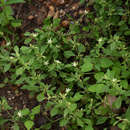en
names in breadcrumbs


Glinus is a genus of tropical and subtropical plants in the family Molluginaceae. Plants of this genus are sometimes called sweetjuice. They are squat annual herbs with fuzzy to hairy green herbage. The fruit is a capsule containing many kidney-shaped seeds. Some species are used as herbal remedies and some are eaten as food.
Glinus oppositifolius at Pocharam lake, Andhra Pradesh, India.
Glinus oppositifolius at Pocharam lake, Andhra Pradesh, India.
Glinus oppositifolius at Pocharam lake, Andhra Pradesh, India.
Glinus oppositifolius (Rau Dang) stir fried with Sambal Belacan
Glinus is a genus of tropical and subtropical plants in the family Molluginaceae. Plants of this genus are sometimes called sweetjuice. They are squat annual herbs with fuzzy to hairy green herbage. The fruit is a capsule containing many kidney-shaped seeds. Some species are used as herbal remedies and some are eaten as food.

Glinus oppositifolius at Pocharam lake, Andhra Pradesh, India.

Glinus oppositifolius at Pocharam lake, Andhra Pradesh, India.

Glinus oppositifolius at Pocharam lake, Andhra Pradesh, India.

Glinus oppositifolius (Rau Dang) stir fried with Sambal Belacan
Glinus es un género de plantas tropicales y subtropicales de la familia Molluginaceae.
Son plantas herbáceas caducas. Es fruto es una cápsula que contiene semillas en forma de riñón. Son utilizadas como plantas medicinales o para la alimentación.
Glinus es un género de plantas tropicales y subtropicales de la familia Molluginaceae.
Son plantas herbáceas caducas. Es fruto es una cápsula que contiene semillas en forma de riñón. Son utilizadas como plantas medicinales o para la alimentación.
Glinus L. é um género botânico pertencente à família Molluginaceae.[1]
Glinus L. é um género botânico pertencente à família Molluginaceae.
Chi Rau đắng (danh pháp khoa học: Glinus) là chi thực vật có hoa gồm các loài cây nhiệt đới và cận nhiệt đới thuộc họ Cỏ bình cu (Molluginaceae) được mô tả lần đầu tiên bởi Carl Linnaeus. Chúng chủ yếu là các loài thân thảo hàng năm, lá có phủ lớp lông mờ. Hạt hình thận được chứa trong quả nang. Hầu hết chúng đều được con người sử dụng thường xuyên, một số loài dùng làm cây thuốc, một số loài dùng làm thực phẩm.
Rau đắng được dùng để chế biến hay ăn kèm các món canh và lẩu như canh rau đắng,[1] cháo cá quả rau đắng,[2] lẩu cháo ếch rau đắng, lẩu cá kèo,...
Glinus oppositifolius (rau đắng đất) ở Andhra Pradesh, Ấn Độ.
Glinus oppositifolius (rau đắng đất) ở Andhra Pradesh, Ấn Độ.
Glinus oppositifolius (rau đắng đất) ở Andhra Pradesh, Ấn Độ.
Glinus oppositifolius (rau đắng đất).
Chi Rau đắng (danh pháp khoa học: Glinus) là chi thực vật có hoa gồm các loài cây nhiệt đới và cận nhiệt đới thuộc họ Cỏ bình cu (Molluginaceae) được mô tả lần đầu tiên bởi Carl Linnaeus. Chúng chủ yếu là các loài thân thảo hàng năm, lá có phủ lớp lông mờ. Hạt hình thận được chứa trong quả nang. Hầu hết chúng đều được con người sử dụng thường xuyên, một số loài dùng làm cây thuốc, một số loài dùng làm thực phẩm.